 |
|

|
 |
TABLE of CONTENTS
 |
Governorís proposal pumps $11 billion into transportation over next decade |
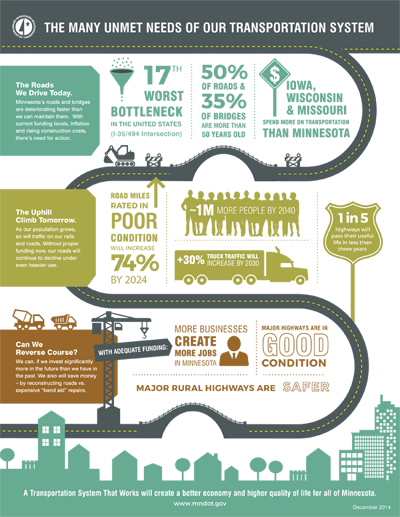
This infographic highlights the many unmet needs of Minnesota's transportation system. |
Gov. Mark Dayton announced his $11 billion plan to address Minnesota’s transportation needs for the next 10 years at a news conference Jan. 26.
Speaking from the Veterans Service Building, his temporary headquarters while the State Capitol is being renovated, the governor said his transportation proposal would invest:
- $6 billion for roads and bridges
- $2.36 billion in local government transportation projects
- $2.92 billion for Twin Cities metro and Greater Minnesota transit systems
“Inadequate transportation clogs our lives with worse traffic congestion, longer commutes, more dangerous travel conditions. Those deficiencies restrict our future economic growth and detract from our quality of life,” Dayton said. “If we continue to avoid these problems, they will only get worse. It’s time to begin to solve them. I urge the Legislature to work with me this session to begin to repair and improve Minnesota’s transportation systems.”
Commissioner Charlie Zelle noted that half of the pavements in the state are more than 50 years old and 35 percent of all state bridges are also half a century old or older. In addition, during the next decade, more than 4,000 miles of roadway pavement is expected to reach the end of its anticipated service life.
“The state’s foremost experts agree on two things: this problem is real, and it cannot be resolved without a major investment,” said Zelle, referring to a panel of policymakers, business and labor leaders, Cabinet officials, and city and county officials that the governor convened in 2012 to study Minnesota’s transportation funding needs.
“But Minnesotans didn’t need a bipartisan panel of experts to tell them what they already know – that our transportation system is in serious disrepair, and getting worse. This problem presents us with two simple and starkly different options: invest for the future, or do nothing and let the problem get much worse. We choose to invest," Zelle said.
New funding for road and bridge construction would be provided by a 6.5 percent gross receipts tax on gasoline, raising the current 1.25 percent base tax on vehicle registration fees to 1.5 percent, and raising car registration fees by $10. The governor’s plan also would require MnDOT to generate efficiencies of 15 percent of new revenue.
For more information:
|
 |
|

|
 |
TABLE of CONTENTS
 |
Several 2015 legislative proposals would benefit transportation |
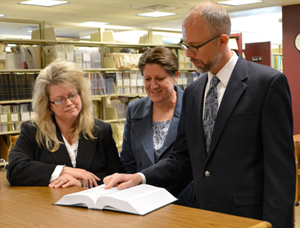
Erik Rudeen, state legislative liaison, discusses a state statute with (from left) Jennifer Witt, agency policy analyst, and Laura Nehl-Trueman, legislative assistant on mobility from the Office of Chief Counsell. Photo by Rich Kemp |
By Rich Kemp
In addition to the governor’s transportation funding package, there are several other legislative proposals affecting MnDOT that are up before the 2015 Legislature. Three key proposals are for rail safety, airport appropriations and a snow and ice contingency account.
- The governor recommends $32.5 million each year for development, administration and construction of highway-rail grade crossing improvements on rail corridors transporting crude oil, and other selected routes, including those carrying hazardous materials.
Improvements include upgrades to existing protection systems, the closing of crossings and necessary roadwork, as well as reconstruction of at-grade crossings to full grade separations. Project improvements are recommended based on risk assessments that include a variety of criteria, such as current and projected train and traffic volumes and delays, community vulnerability assessments, and physical site characteristics. This change item will be funded through an annual assessment on four Class 1 railroads operating in Minnesota.
- The governor recommends one-time appropriations from the State Airports Fund of $5.5 million in FY 2016 and FY 2017 to provide additional funding for construction, pavement maintenance and other improvements at the state’s 135 airports.
In FY 2014 the State Airport Fund was repaid $15 million from the State’s General Fund. In FY 2014 and FY 2015 the Airport Development and Assistance appropriation was increased $1 million and $3 million respectively. There is $11 million remaining and this proposal is to appropriate those funds equally over the next two years FY 2016 and FY 2017. The $4 million that was already appropriated is being distributed in maintenance, equipment and construction grants to local airports. The same is intended for funds being requested in FY 2016 and FY 2017.
-
The governor recommends establishing a snow and ice contingency account/open appropriation in the Trunk Highway Fund when snow and ice costs exceed 110 percent of the previous 10-year full cost yearly average. This account would provide flexibility in covering costs in extreme winters and provide greater assurance in managing public performance expectations throughout the winter season.
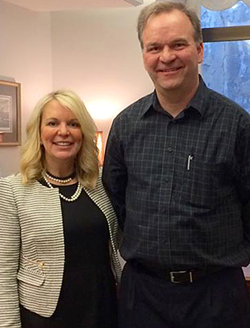
Adam Josephson, Metro east area manager, met with Sen. Karin Housley to discuss projects in the east Metro. Photo courtesy of Sen. Housleyís office |
Snow and ice costs vary from year to year, and managing the uncertainties and unpredictable nature of costs not within the direct control of MnDOT is difficult and often compromises other maintenance activities in the fiscal year. Extreme weather patterns during the past few years in particular resulted in much higher than normal costs associated with providing the level of service expected by the public. Snow and ice costs averaged $86 million over the past 10 years; however, last season’s record high costs of $136 million exceeded the average by $50 million, prompting a supplemental budget request to manage performance and public expectations.
For more information on the 2015 Legislative Session, check out the Government Affairs webpage. The site includes weekly reports for the session. |
 |
|

|
 |
TABLE of CONTENTS
 |
Florida DOT staff checks out MnDOTís snow operations, equipment |
|
By Rich Kemp

From left: Ryan Otte, maintenance research program administrator, was part of the MnDOT team that hosted Mark Thomas, FDOT District 3 maintenance engineer, and Chad Williams, FDOT District 3 assistant maintenance engineer during their visit to Minnesota Jan. 20-23. Photo by Rich Kemp |
It sounds crazy to have the Florida Department of Transportation maintenance staff visit MnDOT to learn how to handle snow and ice. However, Mark Thomas, FDOT District 3 maintenance engineer, said the storm that shut down Atlanta last February made them take a closer look at snow and ice issues.
“The Office of Maintenance was stunned when the Florida DOT approached us to discuss snow and ice,” said Ryan Otte, maintenance research program administrator. “How and what could MnDOT possibly offer to a state in a warm weather climate?”
Thomas, and Chad Williams, FDOT District 3 assistant maintenance engineer, were in Minnesota Jan. 20-23 to learn how MnDOT handles roadways during winter weather. District 3 is located in the Florida Panhandle.
“As the visit waned, I wondered if FDOT could have shared as much information with a traveling group from MnDOT if the trip were reversed,” said Thomas. “I can say that we received a broad spectrum of information in regards to snow and ice abatement. Everyone was very accommodating during the entire course of our visit and thoroughly answered all of our questions regardless of how ‘routine’ the answers may have been to MnDOT personnel. I never once felt that our visit was a burden to those who were sharing their operational knowledge.”
Sue Lodahl, assistant state maintenance engineer, and her staff set up a schedule of events for the Florida visitors. Thomas and Williams started on Tuesday, Jan. 20, at Central Office, where Joe Huneke briefed them on the Maintenance Decision Support System and Jon Bjorkquist talked about the Road Weather Information System.
“After speaking with the engineers from Florida before their visit, it was determined that their climate is prone to freezing rain events,” said Otte. “The southern districts battle this problem most frequently in Minnesota.”
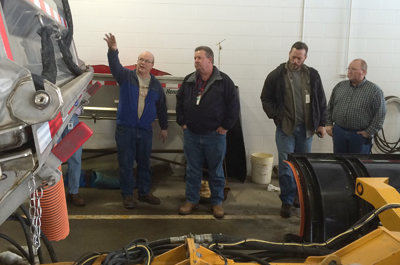
Ron Heim, left, Owatonna sub-area maintenance supervisor, explains the workings of anti-icing equipment to Mark Thomas, FDOT District 3 maintenance engineer, as Chad Williams, FDOT District 3 assistant maintenance engineer, and Wes Smith, District 6 west maintenance superintendent, look on. Photo by Mike Dougherty |
On Jan. 21 they went to the Owatonna Truck Station to check out anti-icing equipment and operations. They met with maintenance supervisors, superintendents, shop supervisors, and area maintenance engineers and operators to discuss how they handle such events. This group presented all aspects of a predicted freezing rain event: the day before, during and after the event. The day ended with a ride in a plow truck pulling a tow plow and using the salt brine production system.
The MnDOT team took the visitors to the Mankato Truck Station on Jan. 22. They attended a regularly scheduled salt solutions meeting where topics such as maintenance operations research, MDSS/AVL, salt handling, anti-icing, and equipment calibration are discussed. This gave the engineers an opportunity to see what goes on behind the scenes when pre-storm planning and post-storm clean up issues are discussed. A site tour of the Mankato facilities followed the meeting. This provided the opportunity to introduce the Florida DOT to the District 7 snow and ice fleet and one of the most state-of-the-art winter chemical mixing stations within MnDOT.
The week ended with a tour of the Central Shop, where they learned what goes into building MnDOT’s fleet of plow trucks, how centralized purchasing of equipment is handled and a general overview of fleet tracking.
“The collective information gleaned from visiting with people from Central Office, Owatonna, Mankato, and the tour of the truck stations around St. Paul resulted in information that will be beneficial to shaping the future of snow and ice handling in Florida,” said Thomas. |
 |
|

|
|

|
 |
TABLE of CONTENTS
 |
Satellite technology aids in providing precise mapping, positioning data |
|
By Sue Roe
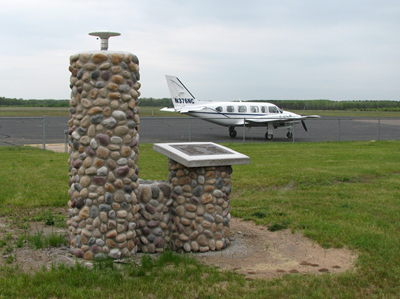
This CORS, on the tall monument on the left, is at the airport in Siren, Wis., and was designed by Burnett County. Other CORS are on placed on buildings. There is also a plaque, shown on the right, that explains the station. Photo by Bud Jorgenson |
A land surveyor is often the first person to do work at a proposed road construction site. His or her job is to collect precise measurements of land boundaries and other structures such as trees, wetlands and vegetation, and utilities so planners can use the data to begin design work.
In days gone by, surveyors used chains, compasses and hand calculators to get these measurements. Today, surveyors rely on satellite technology for more precise and accurate data.
MnDOT uses a network of Continuously Operating Reference Stations or CORS to improve the precision of measurements. Each CORS includes an antenna and receiver that continuously collects data from Global Navigation Satellite System satellites. The GNSS is comprised of multiple navigation systems to pinpoint the geographic location of a user’s receiver anywhere in the world. Data is transmitted via the Internet.
MnDOT’s whole system is called the MnCORS/RTRN/GNSS Network. The RTRN component is the calculation of corrections that are sent to network users via cell phones or wireless modems.
In the users’ receivers, the correction messages are processed along with raw GNSS positions to produce real time coordinates accurate to a few centimeters.
MnDOT’s network consists of 137 permanent base stations throughout the state and surrounding regions, communications links and server computers that calculate corrections. This data can be sent to other mobile GNSS receivers to acquire real-time field positions.
“The goal of the MnCORS network is to reliably deliver low-cost, accurate positioning and navigation solutions to the people of Minnesota and maximize the benefit to our economy by maximizing the use of the network,” said Nathan Anderson, network administrator who works in Land Management.
The CORS network is free and organizations use their own Internet service to access it.
More than 1,000 individual organizations and nearly 3,000 active users access MnDOT’s system annually.
About one-third of the users are MnDOT employees and other agencies such as Federal Aviation Administration, Department of Natural Resources, National Park Service, Metropolitan Council and the Iowa and Wisconsin departments of transportation.
Two-thirds of the accounts are private users, including engineering, utility location, railroad, mining, landscaping and archaeological services. Nearly half of the private users are involved in agriculture-related services, Anderson said.
Besides MnDOT’s surveying teams, other offices using CORS include Aeronautics, Maintenance, Land Management, Environment Stewardship, and Materials.
A pilot project in District 7 is looking at the performance of a snow plow that uses the network to provide real time corrections to an on board computer. The data gives the driver the ability to see road alignments and features such as bridges, guardrails, fog lines, turn lanes and signs.
“The snow plow uses the highly accurate mapping, which requires correction through the network to prevent the plow from hitting a road feature in low visibility conditions,” said Clark Moe, maintenance operations systems coordinator.
MnDOT provides the stations that are located on MnDOT buildings and grounds and MnDOT’s Road Weather Information System sites. MnDOT also partners with cities, counties and private entities to place stations on their sites, and in return, MnDOT uses their Internet services for the CORS stations.
“It’s a great return on investment for MnDOT to provide the system,” Anderson said.
MnDOT’s system, developed for testing in 1996, went public in 2001. It’s been used more than 1.5 million times since 2002.
“As technology advances, the demand for the system is increasing,” Anderson said. “MnDOT will continue to use it more as we find more uses for highly accurate data.”
For more information about the network, contact Anderson at nathan.anderson@state.mn.us and for general questions, email CORSVRS.DOT@state.mn.us. |
 |
|

|
 |
TABLE of CONTENTS
 |
National Center for Asphalt Technology teams up with MnDOT for national pavement research |
By Shannon Fiecke, Research Services & Library
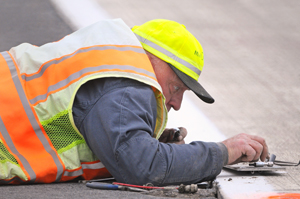
Len Palek, MnROAD program engineer, checks instrumentation at the MnROAD test facility. Photo by David Gonzalez |
The nation’s two largest pavement test tracks are planning their first ever co-experiments.
MnDOT's Road Research Facility and the National Center for Asphalt Technology discussed a formal partnership last year and have now asked states to join two three-year research projects that will begin this summer.
Representatives of the test tracks are meeting next week in Minneapolis at the 19th Annual TERRA Pavement Conference. The partnership will develop a national hot mix asphalt cracking performance test and expand the scope of existing pavement preservation research at the NCAT facility in Auburn, Ala., to include northern test sections in Minnesota.
MnROAD plans to build test sections at its facility and also off-site on a low- and high-volume road, which may include concrete test sections if funding allows. These Minnesota test sections will supplement 25 test sections built in 2010 by NCAT on an existing low-volume haul route and an off-site high-volume test road planned for this summer in Alabama. The test sections will help assess the life-extending benefits of different pavement preservation methods. Both agencies are developing performance tests to predict the cracking potential of asphalt mixes, and they will also work together on that research.
“We will collect and analyze the data in similar ways, and I think we’ll have a greater appeal nationally, as we cover a range of climate conditions,” said Ben Worel, MnROAD operations engineer.
Participation in the pavement preservation study is $120,000 per year for the initial research cycle, which will drop to $40,000 after three years. The cracking study will run three years at $210,000 per year. Alabama will be the lead state for this effort.
State departments of transportation are asked for commitment letters this month if they are interested in joining either study, even if they do not have State Planning and Research dollars available at the time. Participating agencies will design the scope of the research and be kept advised of the ongoing findings so they can benefit early from the project. Participating agencies will hold initial planning meetings through a series of webinars in March and April.
At a Jan. 8 webinar, speakers said the research will help states determine how long pavement preservation treatments will last.
“Many DOTs have really well-designed and well-thought-out decision trees, where they can take pavement management data and end up with a rational selection of pavement alternatives. But the issue of extending pavement life is the really big unknown, because references provide a broad range of expected performance,” said Buzz Powell, NCAT Test Track manager.
Another benefit is that states can learn how pavement treatments hold up in hot and cold climates.
“It’s 14 degrees right now in Mississippi. It rains about every three days, freezes and then thaws,” said Mark McConnell, Mississippi chief engineer. “So we need to know how pavement preservation is going to work in the north as well.”
For additional information, contact Ben Worel (ben.worel@state.mn.us) at MnROAD or Buzz Powell (buzz@auburn.edu) at NCAT.
|
 |
|

|
 |
TABLE of CONTENTS
 |
Ideascale has improved quality, process for research ideas |
By Bob Filipczak
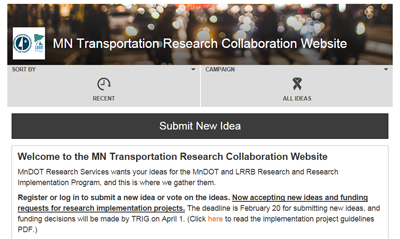
Ideascale is a new online tool used by Research Services to solicit ideas for next yearís research projects. |
This is a busy season for MnDOT’s Research Services team, which currently is looking for new ideas for research implementation projects in 2015. Soon after they’re finished, they’ll begin soliciting ideas for next year’s research projects.
The online tool that will help them in this work is called Ideascale, and it has improved the process in several ways.
First, it has improved the quality of the ideas submitted. In the past, the team would send an email, with a form attached, to everyone on its lists, according to Bruce Holdhusen, who manages Ideascale. Now, Research Services sends an email with a link to the Ideascale website. This gives participants more context for their ideas because they can see what ideas other people are posting and they can also see the seven research categories in which MnDOT is looking for ideas.
“It’s faster for our customers to throw an idea out there. I think it’s improved the quality and of course the transparency and communication,” said Holdhusen.
Second, MnDOT and the Local Road Research Board can more easily review and prioritize the research ideas. That means helping participants who have the best ideas to write and edit a two-page research need statement that is the basis for all proposals that go forward. In the past, with the attached form, the need statements that Research Services received were hit-and-miss.
Once prioritized, ideas and research need statements are ranked by the Minnesota Local Road Research Board and the MnDOT Transportation Research and Innovation Group. The 25-30 ideas that make the cut are then posted so that researchers at the University of Minnesota and other research institutions can submit proposals and compete for funding.
Finally, because the research need statements are better quality, the proposals they get have also improved. In the past they would only get a handful of proposals that totally aligned with research needs. Now Research Services can insist that “only proposals that answer need statements will be funded,” said Holdhusen.
MN.IT has adopted Ideascale (licenses are available) and the governor’s office recently used it for the Unsession initiative.
The deadline for ideas for new research implementation plan ideas is Feb. 20. More information can be found on the Research Services website.
|
 |
|

|
 |
TABLE of CONTENTS
 |
Whatís new on the web |
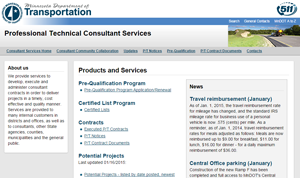
The Consultant Services website has been updated and is now in an accessible mobile-friendly format. |
Consultant Services website
MnDOT’s Consultant Services website serving the Professional/Technical contracting community recently got a facelift, and is now in an accessible mobile-friendly format.
Customers can view the latest P/T contract notices and lists of recently executed contracts on their smartphones or tablets, and find P/T contracting guidance on a variety of topics including the consultant Pre-qualification Program and Certified List Program.
Consultant Services helps MnDOT staff to develop, execute and administer consultant contracts in order to deliver projects in a timely, cost effective and quality manner. Check them out at mndot.gov/consult. |
 |
|
| |
|



